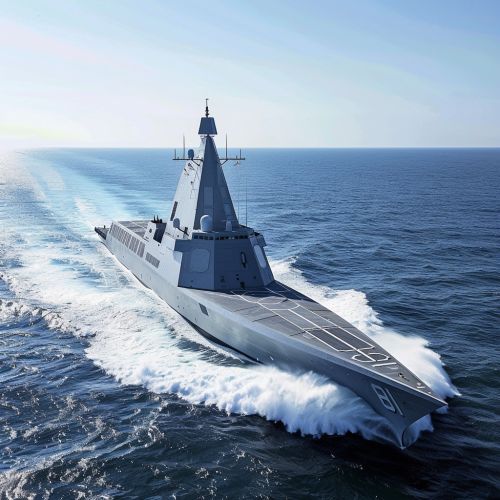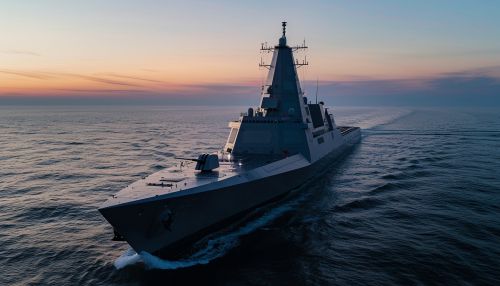Zumwalt-class destroyer
Introduction
The Zumwalt-class destroyer is a class of advanced multi-mission stealth destroyers built for the United States Navy. Designed with a focus on land attack and littoral dominance, the Zumwalt-class represents a significant leap in naval technology and capabilities. This article delves into the intricate details of the Zumwalt-class destroyers, exploring their design, capabilities, and operational history.
Design and Development
The Zumwalt-class destroyers were conceived as part of the U.S. Navy's DD(X) program, which aimed to develop a next-generation destroyer to replace the aging Arleigh Burke-class and Ticonderoga-class ships. The program emphasized advanced technologies, including stealth, automation, and advanced weaponry.
Stealth Features
One of the most notable features of the Zumwalt-class is its stealth design. The ship's angular shape and composite materials significantly reduce its radar cross-section, making it appear as a small fishing boat on enemy radars. This stealth capability is further enhanced by the use of radar-absorbent materials and an integrated electric propulsion system that minimizes acoustic and infrared signatures.
Hull and Superstructure
The Zumwalt-class features a unique tumblehome hull design, which slopes inward from the waterline to the deck. This design improves stability and reduces radar cross-section. The superstructure is made of composite materials, which are lighter and more durable than traditional steel. The ship's deckhouse is fully enclosed, housing sensors and communication equipment to protect them from the elements and enemy fire.


Propulsion and Power Systems
The Zumwalt-class destroyers are powered by an Integrated Power System (IPS), which uses two Rolls-Royce MT30 gas turbines and two Rolls-Royce RR4500 turbine generators. This all-electric propulsion system provides 78 megawatts of power, allowing the ship to reach speeds of over 30 knots. The IPS also powers the ship's advanced weaponry and sensor systems, ensuring a high degree of operational flexibility.
Integrated Power System (IPS)
The IPS is a revolutionary system that integrates the ship's propulsion and power generation systems. This allows for greater efficiency and flexibility in power distribution, enabling the ship to support advanced weaponry and sensor systems. The IPS also reduces the ship's acoustic signature, making it harder to detect by enemy submarines.
Armament and Sensors
The Zumwalt-class destroyers are equipped with an array of advanced weaponry and sensor systems designed for multi-mission capabilities, including land attack, surface warfare, and anti-aircraft warfare.
Advanced Gun System (AGS)
The primary armament of the Zumwalt-class is the Advanced Gun System (AGS), which consists of two 155mm naval guns. These guns are capable of firing Long Range Land Attack Projectiles (LRLAP) up to 83 nautical miles, providing precision fire support for ground forces. The AGS is fully automated, reducing the need for manual loading and increasing the rate of fire.
Vertical Launch System (VLS)
The Zumwalt-class is equipped with 80 Mk 57 Vertical Launch System (VLS) cells, which can launch a variety of missiles, including Tomahawk cruise missiles, Evolved Sea Sparrow Missiles (ESSM), and Standard Missiles (SM-2 and SM-6). This provides the ship with a versatile and powerful offensive and defensive capability.
Radar and Sensor Systems
The Zumwalt-class features the AN/SPY-3 Multi-Function Radar (MFR) and the AN/SPY-4 Volume Search Radar (VSR). These radars provide comprehensive situational awareness, tracking air and surface targets simultaneously. The ship also includes advanced sonar systems for anti-submarine warfare, including the AN/SQQ-90 suite, which integrates hull-mounted and towed-array sonars.
Automation and Crew
One of the key innovations of the Zumwalt-class is its high degree of automation, which significantly reduces the required crew size. The ship's advanced automation systems handle many of the tasks traditionally performed by sailors, including damage control, maintenance, and weapon systems operation.
Reduced Crew Size
The Zumwalt-class destroyers have a crew complement of approximately 140 sailors, compared to the 300+ crew members required for Arleigh Burke-class destroyers. This reduction in crew size is made possible by the ship's advanced automation systems, which streamline operations and reduce the workload on individual sailors.
Habitability
The Zumwalt-class also features improved habitability for its crew. The ship includes modern living quarters, recreational facilities, and advanced medical facilities, ensuring a higher quality of life for sailors during extended deployments.
Operational History
The lead ship of the class, USS Zumwalt (DDG-1000), was commissioned in October 2016. Since then, the Zumwalt-class destroyers have undergone extensive testing and evaluation to integrate their advanced systems and capabilities into the U.S. Navy's fleet.
Initial Deployment and Testing
Following its commissioning, USS Zumwalt underwent a series of sea trials and testing to validate its systems and capabilities. These tests included live-fire exercises, radar and sensor evaluations, and propulsion system trials. The ship also participated in joint exercises with other U.S. Navy vessels and allied navies to demonstrate its multi-mission capabilities.
Future Deployments
The Zumwalt-class destroyers are expected to play a key role in future naval operations, particularly in contested littoral environments. Their advanced stealth, firepower, and sensor systems make them well-suited for a variety of missions, including land attack, surface warfare, and anti-aircraft warfare. The U.S. Navy plans to continue integrating the Zumwalt-class into its fleet, leveraging their advanced capabilities to enhance overall naval effectiveness.
